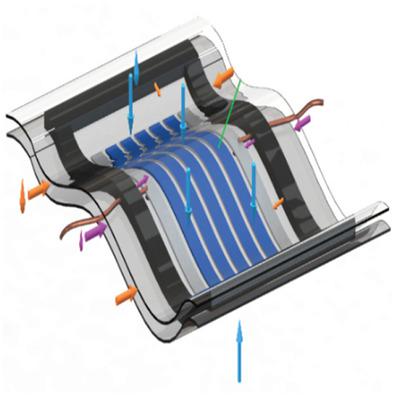当前位置:
X-MOL 学术
›
Adv. Energy Mater.
›
论文详情
Our official English website, www.x-mol.net, welcomes your
feedback! (Note: you will need to create a separate account there.)
A Review on Emerging Barrier Materials and Encapsulation Strategies for Flexible Perovskite and Organic Photovoltaics
Advanced Energy Materials ( IF 24.4 ) Pub Date : 2021-07-20 , DOI: 10.1002/aenm.202101383 Luke J. Sutherland 1, 2 , Hasitha C. Weerasinghe 1 , George P. Simon 2
Advanced Energy Materials ( IF 24.4 ) Pub Date : 2021-07-20 , DOI: 10.1002/aenm.202101383 Luke J. Sutherland 1, 2 , Hasitha C. Weerasinghe 1 , George P. Simon 2
Affiliation

|
Perovskite solar cells (PSCs) and organic photovoltaics (OPVs) have undergone rapid development within the last decade, exhibiting exciting properties such as high efficiency, flexibility, and the potential for large-scale fabrication through roll-to-roll (R2R) processing. Despite this, operational stability is recognized to be an ongoing challenge as prolonged device lifetimes are scarcely observed. This instability can be narrowed down to both “intrinsic degradation” and “extrinsic degradation,” with exposure to moisture and oxygen having detrimental effects on device performance. A means of delaying the degradation of flexible PSC and OPV devices is through barrier encapsulation. Despite glass encapsulation exhibiting ideal barrier properties, the potential for flexible devices and high-throughput R2R fabrication requires the development of flexible barrier materials and encapsulation strategies. These barriers must demonstrate outstanding moisture permeation resistance, high transparency, chemical and thermal stability, and must be able to withstand repeated mechanical deformation. Herein, the fundamental principles of PSC and OPV devices are initially discussed, highlighting the degradation mechanisms and current stability obstacles. A review of the latest flexible barrier materials and encapsulation strategies follows, introducing stability studies that have been undertaken on flexible PSCs and OPV, along with suggestions as to the direction that future research may take.
中文翻译:

柔性钙钛矿和有机光伏的新兴阻挡材料和封装策略综述
钙钛矿太阳能电池 (PSC) 和有机光伏 (OPV) 在过去十年中经历了快速发展,表现出令人兴奋的特性,例如高效率、灵活性以及通过卷对卷 (R2R) 加工进行大规模制造的潜力。尽管如此,操作稳定性被认为是一个持续的挑战,因为几乎没有观察到延长的设备寿命。这种不稳定性可以缩小为“内在退化”和“外在退化”,因为暴露在水分和氧气中会对器件性能产生不利影响。延迟柔性 PSC 和 OPV 设备退化的一种方法是通过屏障封装。尽管玻璃封装表现出理想的阻隔性能,柔性器件和高通量 R2R 制造的潜力需要开发柔性屏障材料和封装策略。这些屏障必须表现出出色的防透湿性、高透明度、化学和热稳定性,并且必须能够承受反复的机械变形。在此,初步讨论了 PSC 和 OPV 设备的基本原理,重点介绍了退化机制和当前的稳定性障碍。随后对最新的柔性阻隔材料和封装策略进行了回顾,介绍了对柔性 PSC 和 OPV 进行的稳定性研究,以及有关未来研究方向的建议。这些屏障必须表现出出色的防透湿性、高透明度、化学和热稳定性,并且必须能够承受反复的机械变形。在此,初步讨论了 PSC 和 OPV 设备的基本原理,重点介绍了退化机制和当前的稳定性障碍。随后对最新的柔性阻隔材料和封装策略进行了回顾,介绍了对柔性 PSC 和 OPV 进行的稳定性研究,以及有关未来研究方向的建议。这些屏障必须表现出出色的防透湿性、高透明度、化学和热稳定性,并且必须能够承受反复的机械变形。在此,初步讨论了 PSC 和 OPV 设备的基本原理,重点介绍了退化机制和当前的稳定性障碍。随后对最新的柔性阻隔材料和封装策略进行了回顾,介绍了对柔性 PSC 和 OPV 进行的稳定性研究,以及有关未来研究方向的建议。强调退化机制和当前的稳定性障碍。随后对最新的柔性阻隔材料和封装策略进行了回顾,介绍了对柔性 PSC 和 OPV 进行的稳定性研究,以及有关未来研究方向的建议。强调退化机制和当前的稳定性障碍。随后对最新的柔性阻隔材料和封装策略进行了回顾,介绍了对柔性 PSC 和 OPV 进行的稳定性研究,以及有关未来研究方向的建议。
更新日期:2021-09-09
中文翻译:

柔性钙钛矿和有机光伏的新兴阻挡材料和封装策略综述
钙钛矿太阳能电池 (PSC) 和有机光伏 (OPV) 在过去十年中经历了快速发展,表现出令人兴奋的特性,例如高效率、灵活性以及通过卷对卷 (R2R) 加工进行大规模制造的潜力。尽管如此,操作稳定性被认为是一个持续的挑战,因为几乎没有观察到延长的设备寿命。这种不稳定性可以缩小为“内在退化”和“外在退化”,因为暴露在水分和氧气中会对器件性能产生不利影响。延迟柔性 PSC 和 OPV 设备退化的一种方法是通过屏障封装。尽管玻璃封装表现出理想的阻隔性能,柔性器件和高通量 R2R 制造的潜力需要开发柔性屏障材料和封装策略。这些屏障必须表现出出色的防透湿性、高透明度、化学和热稳定性,并且必须能够承受反复的机械变形。在此,初步讨论了 PSC 和 OPV 设备的基本原理,重点介绍了退化机制和当前的稳定性障碍。随后对最新的柔性阻隔材料和封装策略进行了回顾,介绍了对柔性 PSC 和 OPV 进行的稳定性研究,以及有关未来研究方向的建议。这些屏障必须表现出出色的防透湿性、高透明度、化学和热稳定性,并且必须能够承受反复的机械变形。在此,初步讨论了 PSC 和 OPV 设备的基本原理,重点介绍了退化机制和当前的稳定性障碍。随后对最新的柔性阻隔材料和封装策略进行了回顾,介绍了对柔性 PSC 和 OPV 进行的稳定性研究,以及有关未来研究方向的建议。这些屏障必须表现出出色的防透湿性、高透明度、化学和热稳定性,并且必须能够承受反复的机械变形。在此,初步讨论了 PSC 和 OPV 设备的基本原理,重点介绍了退化机制和当前的稳定性障碍。随后对最新的柔性阻隔材料和封装策略进行了回顾,介绍了对柔性 PSC 和 OPV 进行的稳定性研究,以及有关未来研究方向的建议。强调退化机制和当前的稳定性障碍。随后对最新的柔性阻隔材料和封装策略进行了回顾,介绍了对柔性 PSC 和 OPV 进行的稳定性研究,以及有关未来研究方向的建议。强调退化机制和当前的稳定性障碍。随后对最新的柔性阻隔材料和封装策略进行了回顾,介绍了对柔性 PSC 和 OPV 进行的稳定性研究,以及有关未来研究方向的建议。











































 京公网安备 11010802027423号
京公网安备 11010802027423号